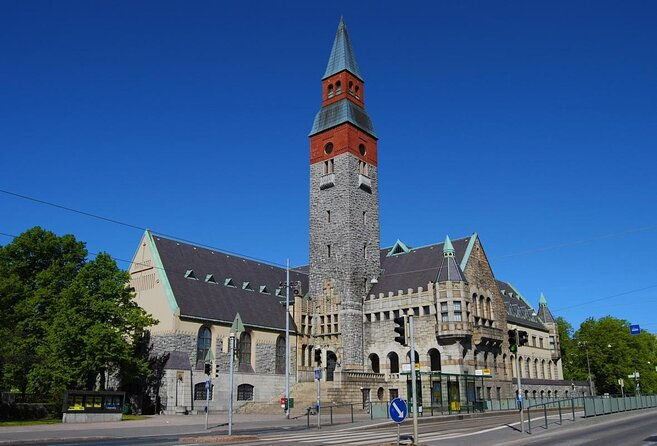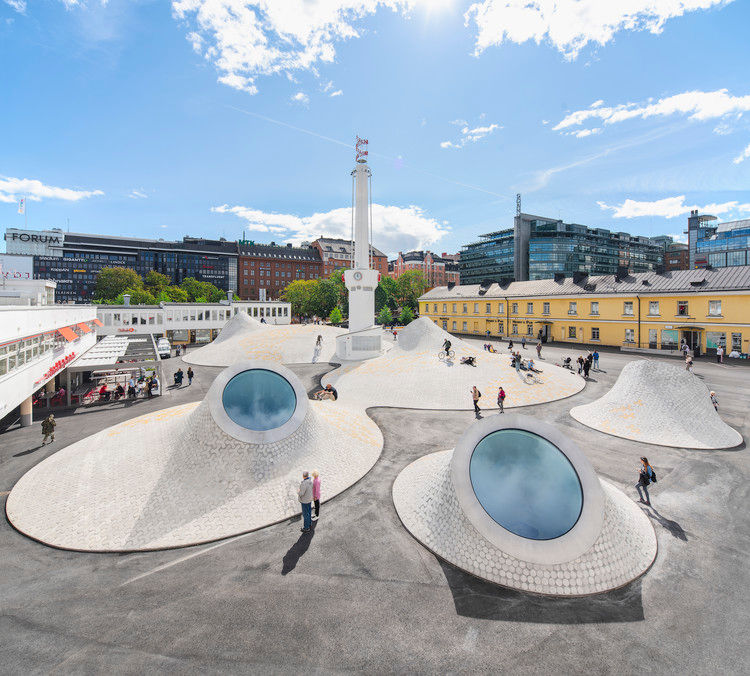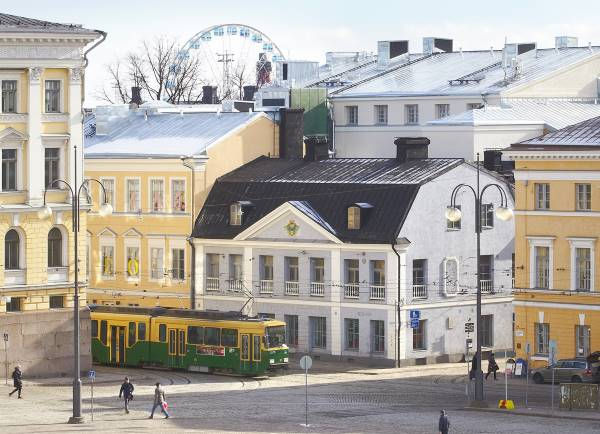Helsinki: Embarking on a Nordic Adventure
- Theresa Wilson
- Jul 26, 2024
- 9 min read
Welcome to Helsinki, a city where the allure of the Nordic landscape meets a rich cultural heritage and a vibrant culinary scene. As the capital of Finland, Helsinki offers an exceptional blend of historical landmarks, innovative design, and tantalizing food and drink that promises to captivate your senses and ignite your spirit of adventure. In this blog post, I will guide you through an unforgettable journey exploring the city's most iconic sites and culinary delights. From the majestic Helsinki Cathedral to the bustling Market Square, you'll discover the architectural gems and historical treasures that define this Nordic gem. We'll also delve into Helsinki's food and drink scene, where traditional Finnish flavors meet contemporary gastronomy. Savor the taste of freshly caught seafood, indulge in hearty Finnish pastries, and experience the warmth of local hospitality in the city's charming cafes and renowned restaurants. Whether you're a history buff, a foodie, or simply an explorer at heart, join us as we embark on a Nordic adventure through the streets of Helsinki. Get ready to uncover the stories behind its landmarks, delight in its culinary offerings, and immerse yourself in the vibrant atmosphere that makes Helsinki a must-visit destination for travelers from around the world.
Iconic Landmarks: Must-See Sites in Helsinki

Suomenlinna; Suomenlinna, known as the ‘Fortress of Finland,’ spans a cluster of car-free islands linked by picturesque bridges. This UNESCO World Heritage site, originally constructed by the Swedes under the name Sveaborg in the mid-18th century, is both visually stunning and historically rich. A visit to Suomenlinna offers a full day's worth of exploration, featuring a variety of attractions such as several intriguing museums, historical bunkers, and imposing fortress walls. The site is also home to Finland's last remaining WWII submarine. Visitors can enjoy numerous cafes and picnic spots scattered throughout the islands, making it an ideal destination for both history enthusiasts and those seeking a relaxing day out.

Ateneum; Housed in a grand neo-Renaissance building from 1887, Finland's premier art gallery provides a comprehensive overview of the nation's artistic heritage. The gallery showcases Finnish paintings and sculptures from the late 19th century through the 1950s, featuring masterpieces by renowned artists such as Albert Edelfelt, Hugo Simberg, Helene Schjerfbeck, Pekka Halonen, and the von Wright brothers. The highlight of the collection is a triptych by the prolific Akseli Gallen-Kallela, which illustrates scenes from the Finnish national epic, the Kalevala, including the dramatic pursuit of the maiden Aino by Väinämöinen. In addition to its Finnish collection, the gallery boasts a notable selection of 19th- and early 20th-century foreign art. Among its treasures is the first-ever Van Gogh acquired by a museum, Street in Auvers-sur-Oise (1890), which was purchased in 1903. The ground floor features the Ateneum Bistro, a contemporary Finnish café and restaurant, as well as a well-curated bookshop and a reading room. Visitors can also enjoy one-hour guided tours in English, included with admission, which are offered at noon on the second and fourth Sunday of each month.

Kansallismuseo; Opened in 1916 and designed in the National Romantic art nouveau style, Finland’s premier historical museum resembles a Gothic cathedral with its robust stonework and towering square spire. After a significant renovation in 2019, the museum now features a range of captivating exhibits, including an exceptional prehistory section and the Realm exhibition, which spans from the 13th to the 19th century. For families, there’s also a fantastic hands-on area for children, Workshop Vintti. From the first-floor balcony, take a moment to admire the stunning frescoes by Akseli Gallen-Kallela on the ceiling arches, which depict scenes from the Finnish national epic, the Kalevala. During July and August, visitors can enjoy 30-minute guided tours in English at 11:30 a.m. from Tuesday to Friday, included with admission.

Seurasaaren Ulkomuseo; Located 5.5 km northwest of the city center, this exceptional island museum boasts a collection of 87 historic wooden buildings relocated from various parts of Finland. The site features an array of structures, including haylofts, a mansion, a parsonage, and a church, as well as stunning giant rowboats once used to ferry churchgoing communities. Visitors can explore these traditional buildings, where guides in period costumes demonstrate folk dancing and crafts. Beyond the museum’s buildings, the picturesque wooded island offers several charming cafes and scenic spots for leisurely exploration. From mid-June to mid-August, guided tours in English are available daily at 3 p.m. and are included with admission. In May and September, admission prices are reduced to €7 for adults. The island also hosts Helsinki’s largest Juhannus bonfires and is a popular spot for picnicking. To reach the island from central Helsinki, take bus 24.

Kiasma; One of the standout features of Helsinki's modern architectural landscape, Kiasma is a striking, curvaceous building designed by Steven Holl and completed in 1998. This metallic marvel symbolizes the city's embrace of contemporary design and modernization. The museum showcases an eclectic array of Finnish and international contemporary art, including digital works, and offers excellent facilities for children. In addition to its impressive art collection, Kiasma features a theatre, a popular glass-sided café with a terrace, and has become a beloved part of the Helsinki community. The surrounding grassy areas are frequently occupied by locals sunbathing, while skateboarders perform tricks under the watchful eye of the Mannerheim statue just outside. Kiasma also offers guided tours in English, providing deeper insights into its exhibitions and architecture.

Amos Rex; Located beneath the iconic 1936 Lasipalatsi building, the Amos Rex art museum opened its doors in 2018. This modern museum invites visitors to descend via sweeping staircases into its subterranean exhibition halls, where experimental and innovative art seamlessly blend the traditional with the contemporary and the futuristic. The unique design features skylights embedded in the polka-dot ceiling that rise above ground, allowing passersby to catch glimpses of the exhibitions from the square outside.

Kaisaniemi; Spanning 4 hectares in the heart of the city alongside the North Harbour, Töölönlahti, Helsinki's botanical gardens offer a lush retreat with a diverse collection of plants from Finland and other regions on the same latitude, encompassing around 3,600 species in total. The gardens feature 10 interconnected greenhouses that house 800 species from various latitudes, providing a warm and inviting sanctuary for visitors during the colder months.

Helsingin Kaupunginmuseo; This museum complex spans five buildings from various historical periods, including the Sederholmin talo, Helsinki's oldest central building, constructed in 1757 by a wealthy merchant. These historic structures are connected by a modern addition and are complemented by four other museums located at separate sites. The highlight of the complex is the main museum, which boasts a vast collection of 450,000 historical artifacts and over one million photographs. The exhibits offer engaging insights into Helsinki’s evolution from Swedish to Russian rule and its journey to independence. Visitors can also explore three beautiful inner courtyards within the complex. The other museums in the network offer free entry and explore different facets of the city's history and contemporary life through both permanent and temporary exhibitions. The charming Ratikkamuseo showcases vintage trams and provides a glimpse into daily life on Helsinki's streets in past decades. The mustard-colored Ruiskumestarin talo, located in central Helsinki’s oldest wooden townhouse from 1818, offers insights into historical architecture. Additionally, the Työväenasuntomuseo illustrates the living conditions of industrial workers in the early 20th century.
Culinary Delights: Must-Try Food and Drink in Helsinki

Poronkäristys; Poronkäristys is a traditional Sámi dish enjoyed in Finland, Norway, and Sweden, featuring sautéed reindeer meat. Originating from Arctic Lapland, where the indigenous Sámi people have long practiced reindeer herding, this dish is a testament to their culinary heritage. The preparation involves thin slices of reindeer meat sautéed in butter, often with onions, and slowly simmered in beer or stock to achieve a tender, succulent texture. Traditionally, poronkäristys is served with creamy mashed potatoes and lingonberry jam, though it can also be paired with pasta or rice. While you can find this flavorful dish in restaurants across Scandinavia, frozen reindeer meat is readily available in most supermarkets. Recent studies highlight reindeer meat’s health benefits, as it is rich in B-12, omega-3, and omega-6 fatty acids. This nutritional profile contributes to its popularity and year-round consumption.

Silakat; Silakka, or small Baltic herring, is the star ingredient of this traditional Finnish fish specialty. To make silakat, whole cleaned herrings (or herring fillets with skin) are coated in a flour mixture seasoned with salt, pepper, and sometimes lime zest, then pan-fried in hot oil or butter. The result is crispy, golden herring fillets, which are typically seasoned with crushed sea salt and served with mashed potatoes, pickled cucumbers, or lime wedges. For an alternative preparation, the fried silakat can be pickled in vinegar and accompanied by carrots, bay leaves, and onions.

Lohikeitto; Lohikeitto is a rich and creamy Finnish salmon soup, akin to Sweden’s laxsoppa. The soup features tender chunks of salmon fillet, along with diced potatoes and carrots, all simmered in a flavorful, buttery broth enriched with fish stock and cream. This comforting dish, perfect for winter, is generously seasoned with fresh dill and typically served with buttered rye bread or lemon wedges on the side.

Mämmi; Mämmi is a traditional Finnish dish that resembles a porridge or pudding. It is made from a blend of rye flour, rye malt, and water, which is then soaked, seasoned with dark molasses syrup, and baked until it achieves a thick consistency and a deep brown color.
Despite its unique sweet taste, mämmi has been a cherished Finnish treat for centuries, particularly associated with Easter and consumed during Lent. While it originally appeared in its simplest form, occasionally spiced with bitter orange zest, modern variations include flavors like chocolate and vanilla. Traditionally, mämmi is served with a sprinkle of sugar and accompanied by whipped cream, milk, or a thin vanilla sauce. Beyond Finland, this satisfying dish is also enjoyed in Sweden, where it is known as memma.

Sahti; Sahti is a traditional Finnish beer originating from the regions of Kanta-Häme, Päijat-Häme, and Pohjois-Satakunta. This unique brew is crafted using malted barley along with other cereal malts, and a mix of cereals such as rye, barley, wheat, and oats. Distinct from other beers, sahti often includes juniper in its fermentation process, and the wort may be filtered using juniper twigs and rye straws. Produced with local ingredients and adhering to age-old methods and recipes, sahti contains no additives and is neither pasteurized nor filtered.
The beer can vary in color from yellow to dark brown, and its appearance is typically slightly cloudy. With an alcohol content ranging from 6% to 12% ABV, sahti holds a long-standing tradition in the region, with its first written mention dating back to 1792. Historically, sahti was a festive brew enjoyed during special occasions, making it one of the last remaining authentic beers in Western Europe. It is occasionally referred to as ethnobeer, highlighting its cultural significance and historical roots.

Aura; Aura is a semi-soft Finnish blue cheese made from cow’s milk, originally crafted in the city of Turku. Since 1935, its production has been based in the Äänekoski region. Known for its creamy texture and robust, tangy flavor, Aura cheese is reminiscent of Roquefort with its sharp, salty notes. Named after the Aura River, the cheese is available in two varieties: the regular version, aged for six weeks, and Aura Gold, which is aged for twelve weeks. Aura cheese is a versatile ingredient, often used as a filling in rolled stuffed salmon or in the preparation of cheese soups.

Turunmaa; Turunmaa is a semi-hard Finnish cheese produced by Valio Ltd since 1931 in the Turku region. Made from cow's milk, this rindless cheese features a creamy yet firm texture. Its flavor profile is mild with a hint of sharpness and tanginess. Typically aged for a minimum of 7 weeks, Turunmaa has a fat content of approximately 50%. It is commonly enjoyed at breakfast, often served alongside bread and fruit.

Mustikkapiirakka; Mustikkapiirakka is a classic Finnish blueberry pie, cherished for its simple yet delicious flavors. The pie’s crust is typically made from a blend of flour, butter, sugar, eggs, and baking powder. The dough is pressed into a tart pan, pricked with a fork, and pre-baked to form a crisp base. For the filling, fresh blueberries—often bilberries in Finland, which are similar but distinct from North American blueberries—are combined with sour cream, eggs, sugar, vanilla, and optionally, cardamom. This mixture is poured over the pre-baked crust and the pie is returned to the oven, where it bakes until the filling is set and the edges are golden brown. Once baked, mustikkapiirakka can be served either warm or cold. It’s often enjoyed with a dollop of whipped cream or a scoop of vanilla ice cream on the side for an extra touch of indulgence.

Lakka; Lakka is a distinctive amber Finnish liqueur crafted from cloudberries—wild orange berries native to the Northern Hemisphere. These berries are macerated in a neutral spirit, and the liqueur is then enriched with honey and spices such as cinnamon and cloves. The result is a bittersweet and aromatic liqueur with subtle berry undertones, and its alcohol content can vary depending on the brand. Typically enjoyed neat, Lakka also makes a delightful addition to various cocktails. Popular brands include Chymos and Lapponia.

Munavoi; Munavoi is a classic Finnish spread made by combining whipped butter with mashed hard-boiled eggs. This spread is known for its distinctive coarse texture and mild, buttery flavor, with just a touch of salt and pepper for seasoning. In Finland, it is commonly spread on bread or served atop Karelian pies. Munavoi is also a beloved staple in traditional Estonian cuisine.


Comments